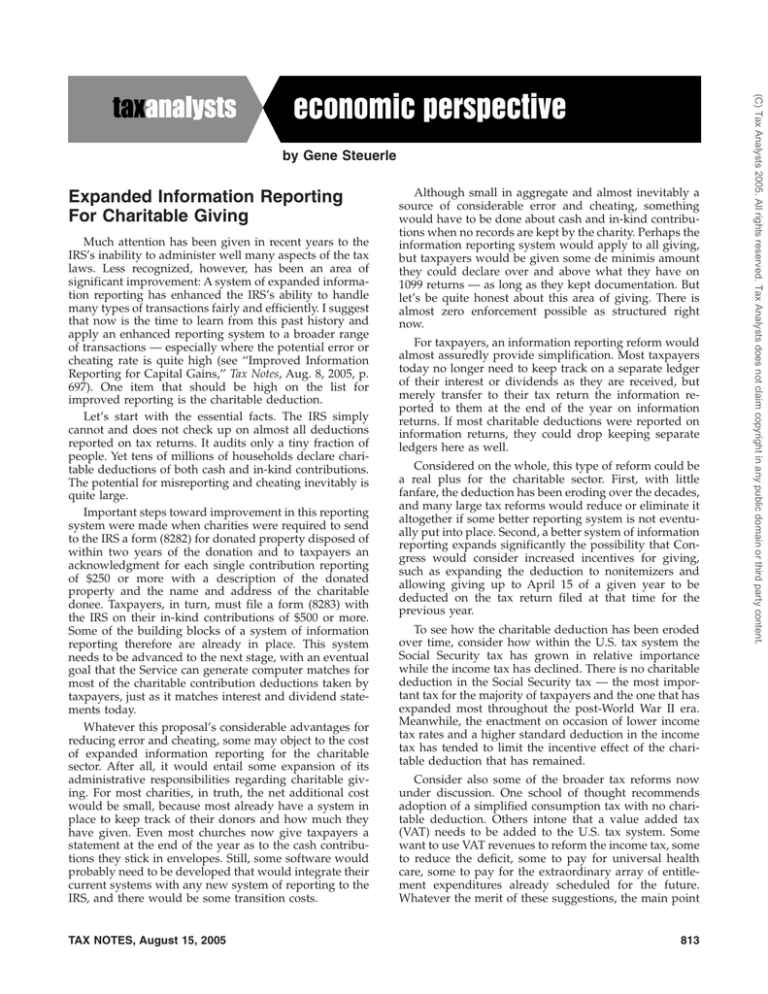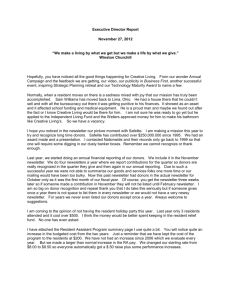
Expanded Information Reporting
For Charitable Giving
Much attention has been given in recent years to the
IRS’s inability to administer well many aspects of the tax
laws. Less recognized, however, has been an area of
significant improvement: A system of expanded information reporting has enhanced the IRS’s ability to handle
many types of transactions fairly and efficiently. I suggest
that now is the time to learn from this past history and
apply an enhanced reporting system to a broader range
of transactions — especially where the potential error or
cheating rate is quite high (see ‘‘Improved Information
Reporting for Capital Gains,’’ Tax Notes, Aug. 8, 2005, p.
697). One item that should be high on the list for
improved reporting is the charitable deduction.
Let’s start with the essential facts. The IRS simply
cannot and does not check up on almost all deductions
reported on tax returns. It audits only a tiny fraction of
people. Yet tens of millions of households declare charitable deductions of both cash and in-kind contributions.
The potential for misreporting and cheating inevitably is
quite large.
Important steps toward improvement in this reporting
system were made when charities were required to send
to the IRS a form (8282) for donated property disposed of
within two years of the donation and to taxpayers an
acknowledgment for each single contribution reporting
of $250 or more with a description of the donated
property and the name and address of the charitable
donee. Taxpayers, in turn, must file a form (8283) with
the IRS on their in-kind contributions of $500 or more.
Some of the building blocks of a system of information
reporting therefore are already in place. This system
needs to be advanced to the next stage, with an eventual
goal that the Service can generate computer matches for
most of the charitable contribution deductions taken by
taxpayers, just as it matches interest and dividend statements today.
Whatever this proposal’s considerable advantages for
reducing error and cheating, some may object to the cost
of expanded information reporting for the charitable
sector. After all, it would entail some expansion of its
administrative responsibilities regarding charitable giving. For most charities, in truth, the net additional cost
would be small, because most already have a system in
place to keep track of their donors and how much they
have given. Even most churches now give taxpayers a
statement at the end of the year as to the cash contributions they stick in envelopes. Still, some software would
probably need to be developed that would integrate their
current systems with any new system of reporting to the
IRS, and there would be some transition costs.
TAX NOTES, August 15, 2005
Although small in aggregate and almost inevitably a
source of considerable error and cheating, something
would have to be done about cash and in-kind contributions when no records are kept by the charity. Perhaps the
information reporting system would apply to all giving,
but taxpayers would be given some de minimis amount
they could declare over and above what they have on
1099 returns — as long as they kept documentation. But
let’s be quite honest about this area of giving. There is
almost zero enforcement possible as structured right
now.
For taxpayers, an information reporting reform would
almost assuredly provide simplification. Most taxpayers
today no longer need to keep track on a separate ledger
of their interest or dividends as they are received, but
merely transfer to their tax return the information reported to them at the end of the year on information
returns. If most charitable deductions were reported on
information returns, they could drop keeping separate
ledgers here as well.
Considered on the whole, this type of reform could be
a real plus for the charitable sector. First, with little
fanfare, the deduction has been eroding over the decades,
and many large tax reforms would reduce or eliminate it
altogether if some better reporting system is not eventually put into place. Second, a better system of information
reporting expands significantly the possibility that Congress would consider increased incentives for giving,
such as expanding the deduction to nonitemizers and
allowing giving up to April 15 of a given year to be
deducted on the tax return filed at that time for the
previous year.
To see how the charitable deduction has been eroded
over time, consider how within the U.S. tax system the
Social Security tax has grown in relative importance
while the income tax has declined. There is no charitable
deduction in the Social Security tax — the most important tax for the majority of taxpayers and the one that has
expanded most throughout the post-World War II era.
Meanwhile, the enactment on occasion of lower income
tax rates and a higher standard deduction in the income
tax has tended to limit the incentive effect of the charitable deduction that has remained.
Consider also some of the broader tax reforms now
under discussion. One school of thought recommends
adoption of a simplified consumption tax with no charitable deduction. Others intone that a value added tax
(VAT) needs to be added to the U.S. tax system. Some
want to use VAT revenues to reform the income tax, some
to reduce the deficit, some to pay for universal health
care, some to pay for the extraordinary array of entitlement expenditures already scheduled for the future.
Whatever the merit of these suggestions, the main point
813
(C) Tax Analysts 2005. All rights reserved. Tax Analysts does not claim copyright in any public domain or third party content.
by Gene Steuerle
COMMENTARY / ECONOMIC PERSPECTIVE
814
Similarly, I have suggested that charitable deductions
for the previous year should be allowed, like deposits to
individual retirement accounts (IRAs), for contributions
made up until a taxpayer files his or her tax return for
that year (See ‘‘Increasing Charitable Giving: The April 15
Solution,’’ Tax Notes, July 9, 1990, p. 221.) Yet I have also
become convinced that the IRS would need a better
system of information reporting to make that possible,
because it would want to be assured that taxpayers did
not declare the deduction twice — on the returns for both
last year and this year. Once again, a system of information reporting would solve the problem. Those deductions could be allowed only for contributions reported (to
both the IRS and the taxpayer) by the charity for the
previous year. That is exactly how financial institutions
report to the taxpayer and the IRS the amount of IRA
contributions and the year to which they apply.
Here, then, is an ideal trade-off. The monies derived
from the improved compliance accompanying a better
system of information reporting could be spent on enhancing charitable incentives — either extending the
deduction to more taxpayers or allowing taxpayers to
benefit immediately from charitable contributions they
make while in the process of filing their tax returns. My
guess is that the combination would increase giving and
compliance at the same time.
The IRS does not administer well items for which it
does not have information reporting. Extending information reporting to most charitable contributions would
simplify life for most individual givers, improve compliance, and likely be better for the charitable sector as well.
An improved information reporting for charitable contributions goes hand-in-hand with the continually improving systems of accounting that accompany the advances
of information technology.
TAX NOTES, August 15, 2005
(C) Tax Analysts 2005. All rights reserved. Tax Analysts does not claim copyright in any public domain or third party content.
here is that no charitable deduction would be allowed for
those alternative or add-on taxes.
On a related front, for a number of years now, tax
analysts have been examining ways to simplify tax return
filing under the existing income tax. A primary candidate
mentioned every few years is for the IRS to do the tax
calculations for a majority of taxpayers. Sometimes that
proposal is put under the banner of a ‘‘return-free’’
system. That terminology is misleading, since taxpayers
would still need to correct any return that the IRS might
prepare for them — for instance, by adding in selfemployment income for which the IRS has little information. But regardless of the label, an IRS-prepared return is
totally dependent on information returns. If charitable
contributions are reported, they could be allowed under
such a reform. If not, the eventual adoption of a returnfree system would likely disallow any charitable deduction for the majority of taxpayers to whom this returnfree system is applied.
How all these various reforms will play out, I do not
know. I do know that if charitable contributions were
subject to a good information reporting system, they
would stand a much better chance of surviving if and
when some significant reform is enacted.
In earlier columns in this publication, I have also
suggested that legislation could simultaneously enhance
incentives to give in exchange for a more administrable
system (See ‘‘A Win-Win Option for Charity and Tax
Policy,’’ Tax Notes, Apr. 18, 2005, p. 361.) Extending the
deduction to nonitemizers, for instance, makes sense
only if the Service can administer that expanded responsibility. It cannot really do so now. Without more auditing
of charitable contributions, it either would do little to
monitor the new claims for charitable deductions or it
would transfer scarce resources away from the already
insufficient monitoring of itemizers.




